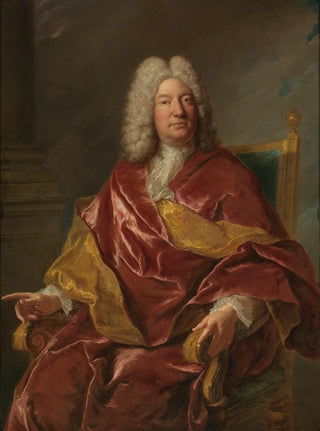Art print | Portrait of a man - Jean-François de Troy


View from behind

Frame (optional)
Reproduction Portrait of a Man - Jean-François de Troy – Captivating Introduction
The "Portrait of a Man" by Jean-François de Troy is a work that transcends the simple framework of individual representation to engage in a broader reflection on identity and social status in the 18th century. This painting, rich in detail and nuance, invites the viewer to immerse themselves in a universe where painting becomes the mirror of the human soul. The finesse of the features, the brilliance of the colors, and the subtle expression of the character captivate the gaze and evoke numerous questions about the life of this man, whose name remains mysterious. In this work, every brushstroke seems to tell a story, a fragment of life frozen in time.
Style and uniqueness of the work
Jean-François de Troy's style is distinguished by his ability to combine realism and idealization. In the "Portrait of a Man," he manages to capture not only the physical traits of his model but also the very essence of his personality. The play of light and shadow, as well as the delicacy of the clothing details, demonstrate remarkable technical mastery. The colors, carefully chosen, evoke an atmosphere that is both intimate and solemn. The artist uses warm tones that envelop the character, creating a strong emotional connection between the subject and the viewer. This portrait, beyond its formal beauty, reveals itself as a psychological exploration, where each exchange of gaze between the painting and the observer becomes an invitation to contemplation.
The artist and his influence
Jean-François de Troy, an emblematic figure of 18th-century French painting, established himself through his talent and keen sense of observation. Trained in the ateliers of great masters, he developed a personal style that combines tradition and innovation. His work draws from Italian influences while incorporating characteristic elements of French classicism. De Troy was also a pioneer in the art of portraiture, helping to elevate this genre to the status of a true work of art. His impact on his contemporaries and future generations is undeniable, as he paved the way for a more psychological and introspective approach to portraiture. By capturing not only appearance but also the

Matte finish

View from behind

Frame (optional)
Reproduction Portrait of a Man - Jean-François de Troy – Captivating Introduction
The "Portrait of a Man" by Jean-François de Troy is a work that transcends the simple framework of individual representation to engage in a broader reflection on identity and social status in the 18th century. This painting, rich in detail and nuance, invites the viewer to immerse themselves in a universe where painting becomes the mirror of the human soul. The finesse of the features, the brilliance of the colors, and the subtle expression of the character captivate the gaze and evoke numerous questions about the life of this man, whose name remains mysterious. In this work, every brushstroke seems to tell a story, a fragment of life frozen in time.
Style and uniqueness of the work
Jean-François de Troy's style is distinguished by his ability to combine realism and idealization. In the "Portrait of a Man," he manages to capture not only the physical traits of his model but also the very essence of his personality. The play of light and shadow, as well as the delicacy of the clothing details, demonstrate remarkable technical mastery. The colors, carefully chosen, evoke an atmosphere that is both intimate and solemn. The artist uses warm tones that envelop the character, creating a strong emotional connection between the subject and the viewer. This portrait, beyond its formal beauty, reveals itself as a psychological exploration, where each exchange of gaze between the painting and the observer becomes an invitation to contemplation.
The artist and his influence
Jean-François de Troy, an emblematic figure of 18th-century French painting, established himself through his talent and keen sense of observation. Trained in the ateliers of great masters, he developed a personal style that combines tradition and innovation. His work draws from Italian influences while incorporating characteristic elements of French classicism. De Troy was also a pioneer in the art of portraiture, helping to elevate this genre to the status of a true work of art. His impact on his contemporaries and future generations is undeniable, as he paved the way for a more psychological and introspective approach to portraiture. By capturing not only appearance but also the






